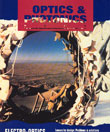
November 1991 Issue
Feature Articles
Lenses by Design Problems and Solutions
Members of the optics community may be interested to know that there is also a series of such challenges in the field of lens design. Lens designers look forward to the series of major conferences devoted to optical design known as the International Lens Design Conferences (ILDC, now the International Optical Design Conference, IODC). ILDCs have been held every five years since 1975, and at each conference there has been at least one lens design problem for members of the community to consider. Problem descriptions are published before the conference and people are invited to submit solutions. The results are presented at the conference and published in the Proceedings.
by Peter ClarkUltra-High Resolution Interferometric Sensors
An extraordinary variety of measurements can be made using optical interferometry. Cheap laser diodes can lead to inexpensive and accurate sensors for such measurements. In most cases, interferometric measurements are made by interfering two beams so that their phase is proportional to the quantity being measured. There are two basic tasks in building a sensor of this type: (1) design the transducer so that the measured phase is proportional to the desired physical parameter and does not depend on other parameters that are likely to change, and (2) devise an appropriate means for processing the data from the transducer. Figure 1 illustrates four basic types of 2-beam interferometers, differentiated in terms of how they generate detectable phase changes.
by Michael HercherPhoto standards and the big picture
At the end of August, about 60 international delegates gathered in Boston for the Plenary Meeting of ISO/TC42—Photography, the first time this ISO Technical Committee has met in the U.S. The meeting was run by the Secretariat for TC42—the National Association of Photographic Manufacturers—and was supported financially and with personnel from NAPM and Polaroid Corp. Eduard Scherrer of NAPM represented the Secretariat.
by Robert E. ParksColors from the black and white
Believe only half of what you see, the adage says. This age-old wisdom is a warning that our sense of sight is easily deceived. Optical illusions can result from geometrical tricks that play havoc with the preconceived notions of our perception—like Escher's prints. They can also result from the very physiology of the eye itself.
by Richard A. Crowe,Electro-optics in Desert Storm
Three basic technologies provided the operational capability observed on nightly television news: the image intensifier devices operating in the visible and near infrared spectrum, thermal devices operating in the 8-12 μm spectral band, and laser devices. It was a great surprise to many that, in general, these systems operated trouble free. Most of the articles about Desert Storm have emphasized the successful impact of fielded systems. Here we would like to highlight some of the problems that arose and the short term electro-optic solutions found to those problems.
by B. D. Guenther, R. Buser, W. Morrow

![Manual probe system with needles for test of semiconductor on silicon wafer. [A. Morozov / Getty]](https://opnmedia.blob.core.windows.net/$web/opn/media/images/articles/2025/1125/departments/202511-cover-web.jpg?ext=.jpg)
![Researcher Clara Saraceno in the lab. [Image by Carsten Behler Photography]](https://opnmedia.blob.core.windows.net/$web/opn/media/images/articles/2025/1025/departments/202510-cover-web.jpg?ext=.jpg)
